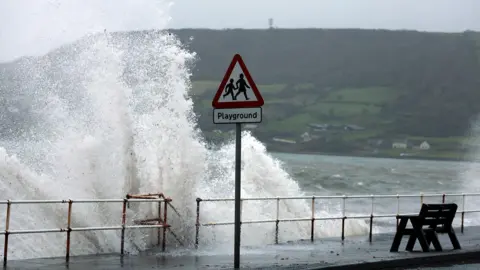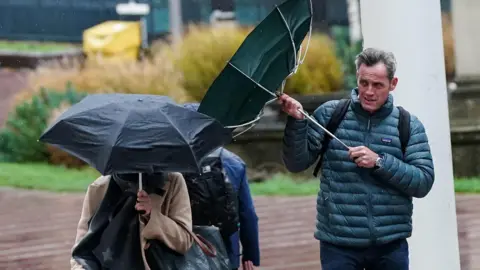News Beat
Storm Bram brings flooding and travel disruption to UK

Trains, flights and ferries were cancelled and thousands left without power on Tuesday as Storm Bram brought heavy rain, strong winds and unseasonably mild temperatures to large parts of the UK.
A fresh amber warning for wind, indicating a possible danger to life, came into effect in north-west Scotland at 16:00 GMT, with gusts of up to 90mph (145 km/h) possible into the early hours of Wednesday.
Less severe yellow warnings for wind which had covered the rest of Scotland, whole of Northern Ireland, Wales and parts of England were set to expire by morning.
As of 20:00, there were 60 flood warnings in place across the UK, with 30 in England, 17 in Wales and 13 in Scotland.
The storm brought in exceptionally mild air, with some regions registering temperatures as high as 16C (60F) – significantly higher than the December average of 5-9C.
In Scotland, several ferry routes on the west coast were cancelled or disrupted, while ScotRail announced some trains in the north-west would finish early with delays and speed restrictions in other parts of the country.
Some Scottish schools closed early due to the forecast.
The new amber warning for very strong and disruptive winds in the north-west of Scotland and Western Isles kicked in at 16:00 and was set to run until 03:00 on Wednesday, while fresh yellow wind warnings were expected to begin for the rest of the country from midnight.
 Reuters
ReutersNorthern Ireland was covered by the less severe yellow wind warning until 22:00, with dozens of flights between the island of Ireland and Great Britain cancelled throughout the day.
Ulster University closed some of its campuses and schools were asked to monitor the weather warnings in their areas.
A yellow warning for wind also covered all of Wales until 19:00, where severe travel disruption was reported.
The M48 Severn Bridge closed due to the high winds, which left drivers facing severe traffic as the alternative Prince of Wales Bridge – connecting Wales and England along the M4 – shut from 20:00 so that lamp-posts at risk of collapse could be taken down.
Various rail services were disrupted as flooding closed all lines between Aberdare and Abercynon in the south, while services between Llandudno and Blaenau Ffestiniog in the north were cancelled after a train hit a tree which had fallen across the line.
A Transport for Wales spokesman said 17 passengers were on board at the time. It is not known if anyone was injured.
 PA Media
PA MediaBoth South Wales and south-west England had seen heavy rain overnight into Tuesday and were covered by amber warnings until 10:00.
BBC South West’s senior broadcast meteorologist David Braine said Dartmoor in Devon had seen almost a month’s worth of rainfall over the preceding 48 hours.
Many houses in Totnes were flooded as the River Dart – which carries water from Dartmoor – grew swollen with rainwater. The rain also disrupted rail services, including some services to London.
Great Western Railway reported cancellations in the west of England due to flooding between:
- Par and Newquay
- Totnes and Plymouth
- Swindon and Bristol Parkway
National Rail warned some Avanti West Coast, CrossCountry, East Midlands Railway and TransPennine Express services were affected – with the full details available on its website.
Thousands in England and Wales were left without power. As of 16:30, just over 4,000 properties had no electricity, according to National Grid.
Storm Bram follows Storm Amy in October, which caused travel disruption, power cuts and storm damage to thousands of homes across the UK.
Named by Ireland’s national weather service, Met Éireann, Storm Bram is expected to cause ongoing disruption throughout Tuesday before clearing on Wednesday.
Why does Storm Bram follow Storm Claudia?
Storm Bram is the fourth named storm to hit the UK this season, after Amy, Benjamin and Claudia – so why did forecasters go back to the letter B?
It comes down to how storms are named and who actually names them, BBC lead weather presenter Matt Taylor says.
The UK’s Met Office, Ireland’s Met Éireann and KNMI in the Netherlands group together to track major storms. Storms are named when they are expected to have a significant impact in at least one of the countries in the group, and are not based on any rainfall or wind speed thresholds.
The alphabetic storm name list is decided jointly by the group every year, following submissions from the public. Storm Bram is only the second storm to be named by the group this season, with the Irish weather service announcing Bram’s naming.
Benjamin was named by the French weather service, and Claudia by the Spanish service because of the impacts the low pressure systems would have in those nations first.











